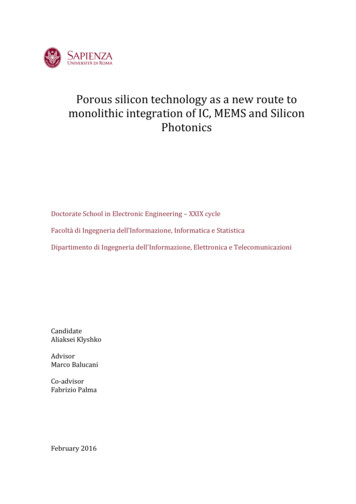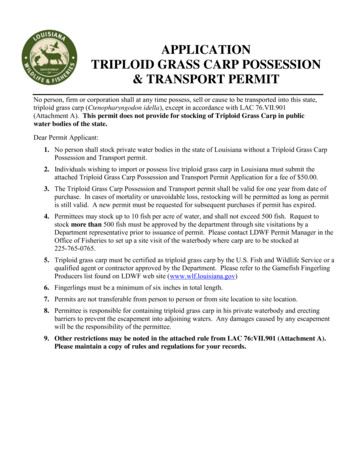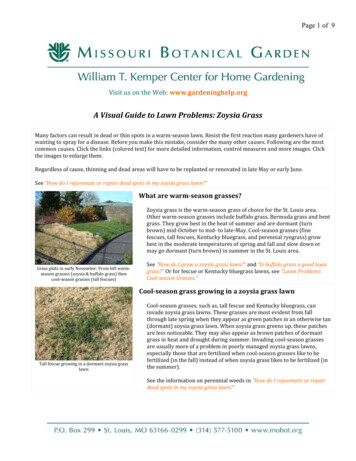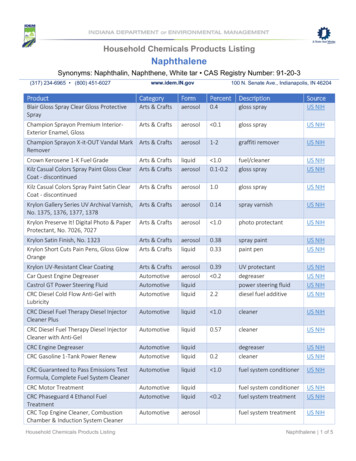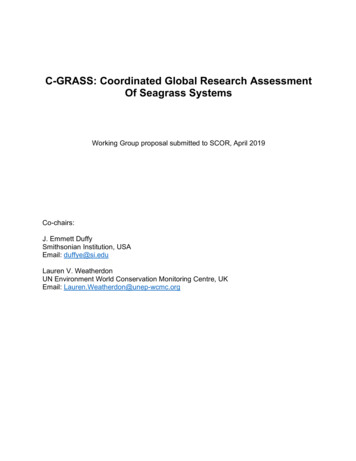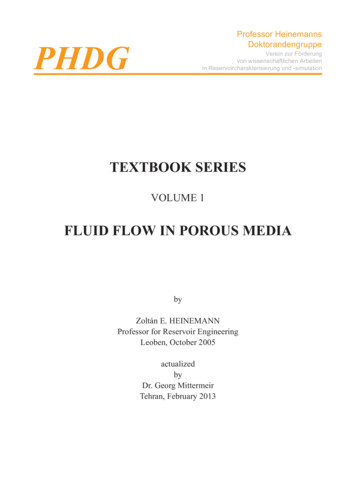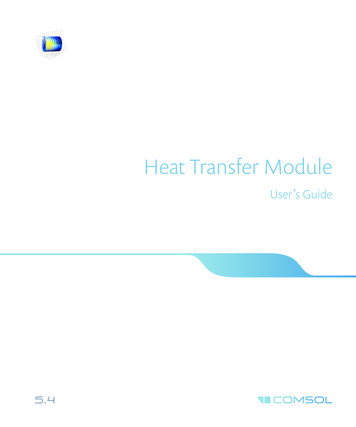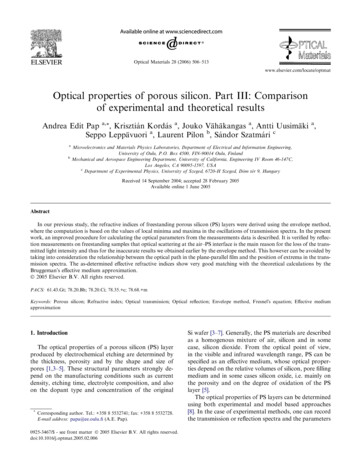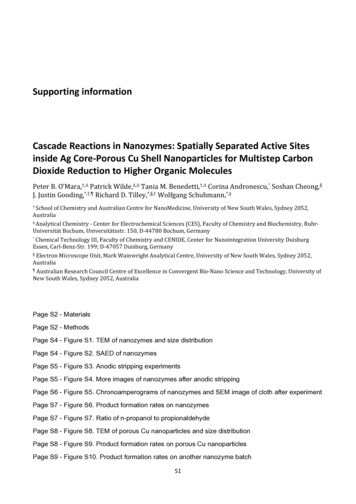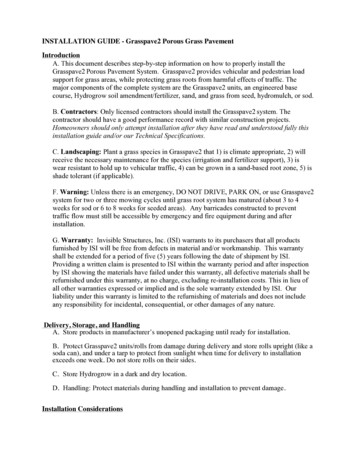
Transcription
INSTALLATION GUIDE - Grasspave2 Porous Grass PavementIntroductionA. This document describes step-by-step information on how to properly install theGrasspave2 Porous Pavement System. Grasspave2 provides vehicular and pedestrian loadsupport for grass areas, while protecting grass roots from harmful effects of traffic. Themajor components of the complete system are the Grasspave2 units, an engineered basecourse, Hydrogrow soil amendment/fertilizer, sand, and grass from seed, hydromulch, or sod.B. Contractors: Only licensed contractors should install the Grasspave2 system. Thecontractor should have a good performance record with similar construction projects.Homeowners should only attempt installation after they have read and understood fully thisinstallation guide and/or our Technical Specifications.C. Landscaping: Plant a grass species in Grasspave2 that 1) is climate appropriate, 2) willreceive the necessary maintenance for the species (irrigation and fertilizer support), 3) iswear resistant to hold up to vehicular traffic, 4) can be grown in a sand-based root zone, 5) isshade tolerant (if applicable).F. Warning: Unless there is an emergency, DO NOT DRIVE, PARK ON, or use Grasspave2system for two or three mowing cycles until grass root system has matured (about 3 to 4weeks for sod or 6 to 8 weeks for seeded areas). Any barricades constructed to preventtraffic flow must still be accessible by emergency and fire equipment during and afterinstallation.G. Warranty: Invisible Structures, Inc. (ISI) warrants to its purchasers that all productsfurnished by ISI will be free from defects in material and/or workmanship. This warrantyshall be extended for a period of five (5) years following the date of shipment by ISI.Providing a written claim is presented to ISI within the warranty period and after inspectionby ISI showing the materials have failed under this warranty, all defective materials shall berefurnished under this warranty, at no charge, excluding re-installation costs. This in lieu ofall other warranties expressed or implied and is the sole warranty extended by ISI. Ourliability under this warranty is limited to the refurnishing of materials and does not includeany responsibility for incidental, consequential, or other damages of any nature.Delivery, Storage, and HandlingA. Store products in manufacturer’s unopened packaging until ready for installation.B. Protect Grasspave2 units/rolls from damage during delivery and store rolls upright (like asoda can), and under a tarp to protect from sunlight when time for delivery to installationexceeds one week. Do not store rolls on their sides.C. Store Hydrogrow in a dark and dry location.D. Handling: Protect materials during handling and installation to prevent damage.Installation Considerations
A. Review installation procedures and coordinate Grasspave2 work with other workaffected. Generally, Grasspave2 is installed at the same time as project grass installation,nearly the last site construction activity.B. Do not begin installation of porous pavements until all hard surface paving adjacent toporous pavement areas, including concrete walks and asphalt paving, is completed.C. Install turf when ambient air temperatures is at least 55 degrees F (13 degrees C).D. In cold weather, do not use frozen materials or materials mixed or coated with ice orfrost, and do not build on frozen base or wet, saturated or muddy subgrade.E. Protect partially completed paving against damage from other construction traffic whenwork is in progress.F. Adequately water sod or grass seed to assure germination of seed and growth of rootsystem.G. Grass coverage on the sand-filled Grasspave2 rings must be completed within one week.H. DO NOT DRIVE, PARK ON, or use Grasspave2 system for two or three mowing cyclesuntil grass root system has matured (about 3 to 4 weeks for sod or 6 to 8 weeks for seededareas). Any barricades constructed must still be accessible by emergency and fire equipmentduring and after installation.MaterialsA. Grasspave2 Porous Paving RollsB. Base Course: Sandy gravel material from local sourcescommonly used for road base construction (recycledmaterials such as crushed concrete or crushedaggregate are NOT acceptable).1. Conforming to the following sieve analysis andrequirements:100 percent passing sieve size 1 inch (25 mm).90-100 percent passing sieve size 3/4 inch (19 mm).70-80 percent passing sieve size 3/8 inch (9 mm).55-70 percent passing sieve size #4.45-55 percent passing sieve size #10.25-35 percent passing sieve size #40.3-8 percent passing sieve size #200.2. Provide a base course material nearly neutral in pH (range from 6.5 to 7.2) to provideadequate root zone development for turf.3. Material may be either "pit run" or "crusher run." Avoid using clay based crusher run/pitrun. Crusher run material will generally require coarse, well-draining sand conforming toAASHTO M6 or ASTM C 33 to be added to mixture (20 to 30 percent by volume) toensure long-term porosity.4. Alternative materials such as crushed shell, limerock, or crushed lava may be used forbase course use, provided they are mixed with sharp sand (20 to 30 percent by volume) toensure long-term porosity, and are brought to proper compaction. Without added sand,crushed shell and limerock set up like concrete and become impervious.5. Alternative size and/or composition of base course materials should be submitted toInvisible Structures, Inc. (Manufacturer) for approval.
C. Sand Fill for Rings and Spaces Between Rings: Clean sharp sand (washed concrete sand).Choose one of the following:1. Coarse, well-draining sand, such as washed concrete sand conforming to AASHTO M6or ASTM C-33.2. United States Golf Association (USGA) greens, section - sand mix “The Root ZoneMixture.”D. Turf Conditioner:1. Hydrogrow a proprietary soil amendment manufactured by Invisible Structures, Inc. andprovided with Grasspave2.2. NO SUBSTITUTIONS.E. Grass – Choose either sod or seed. Use grass species resistant to wear by traffic generally aBlue/Rye/Fescue mix used for athletic fields in northern climates, and Zoysia, Fescue, orBermuda types in southern climates. Check with local sod and seed suppliers for preferredmixtures. Dedicated fire lanes can use same grass species used on surrounding turf. Parkingapplications require greatest wear-resistant species possible, generally available only by seedor hydroseeding/hydro-mulching.1. Sod: Use 13 mm (0.5") thick (soil thickness) rolled sod from a reputable local grower.Species should be wear resistant, free from disease, and in excellent condition. Sod shallbe grown in sand or sandy loam soils only. Sod grown in soils of clay, silt, or highorganic materials such as peat, will not be accepted.2. Seed: Use seed materials, of the preferred species for local environmental and projectedtraffic conditions, from certified sources. Seed shall be provided in containers clearlylabeled to show seed name, lot number, net weight, % weed seed content, and guaranteed% of purity and germination. Pure Live Seed types and amount shall be as shown onplans.a. Mulch – needed only for hydroseeding: Wood or paper cellulose commercial mulchmaterials compatible with hydroseeding operations. Mulch depth according to mulchmanufacturers’ recommendation. DO NOT use mulch of straw, pine needles, etc.,because of their low moisture holding capacity.b. Topsoil – needed only for seeding, recommended for hydroseeding: Obtain specifiedtopsoil for a light “dusting” (NO MORE than ½” or 13mm) above rings filled withsand for seeding germination.F. Fertilizer: A commercial "starter" fertilizer, with Guaranteed Analysis of 17-23-6, or asrecommended by local grass supplier, for rapid germination and root development.G. Grasspave2 Sign: A sign to identify the presence of Grasspave2 paving, stating that specialmaintenance is required, with the Manufacturer's phone number, and made of durablematerials for outdoor exposure shall be provided and installed.H. Fire lane Signage & Delineation: Fire lanes must be identified regarding their entrance andphysical location with the placement of signs, gates, curbs, bollards, etc. Specific signagewording and other details must be coordinated with and approved by local fire authorities.INSTALLATIONInspection(For Fire lanes and emergency access, It is recommended that Fire Department inspectors bescheduled to inspect installation of Grasspave2 during preparation of the subbase, installation ofthe base course, and installation of Grasspave2 units. Most small projects can accommodatethese inspections all on the same day. Verify with Fire Department if certificates of inspectionare required.)
A. Examine subgrade and base course installed conditions. Do not start porous pavinginstallation until unsatisfactory conditions are corrected. Check for improperly compactedtrenches, debris, and improper gradients.B. For fire lane installations: prior to installing base course for turf paving, obtain approval oflocal fire authorities of sub-base.C. Start of installation constitutes acceptance of existing conditions and responsibility forsatisfactory performance. If existing conditions are found unsatisfactory, contact Architectfor resolution.Preparation(Ensure that subbase materials are structurally adequate to receive designed base course,wearing course, and designed loads. Generally, excavation into undisturbed normal strengthsoils will require no additional modification. Fill soils and otherwise structurally weak soilsmay require modifications, such as geotextiles, geogrids, and/or compaction (not to exceed90%). Ensure that grading and soil porosity of the subbase will provide adequate subsurfacedrainage)A. Subgrade Preparation:1. Prepare subgrade as specified for project.2. Proper subgrade preparation will enable the Grasspave2 rolls/units to connect properlyand remain level and stationary after installation.3. Excavate area allowing for unit thickness (1 in), the engineered base depth (whererequired), and 0.5 inch (1.25 cm) for depth of sod root zone or topsoil germination area(when applicable).4. Provide adequate drainage from excavated area if area has potential to collect water,when working with in-place soils that have poor permeability.5. Ensure in-place soil is relatively dry and free from standing water.6. Uniformly grade base.7. Level and clear base of large objects, such as rocks and pieces of wood.B. Base Preparation:1. Install Base as specified.2. Coordinate base installation and preparation withsubdrains (if necessary).3. If required, place a geotextile separation layerbetween the natural ground and the ‘engineered base’.4. If required, install the specified sub-drain and outletaccording to construction drawings.5. Coordinate base installation and preparation withirrigation and drip irrigation lines.6. Place engineered base in lifts not to exceed 6 inches(150 mm), compacting each lift separately to 95percent Modified Proctor.7. Leave 1 inch (2.5 cm) of depth below final grade for porous paver unit and sand fill and0.5 inch (1.25 cm) for depth of sod root zone or topsoil germination area (whenapplicable).Hydrogrow InstallationA. Spread all Hydrogrow mix provided (spreader rate 4.53kg per 100 m2 (10 lbs per 1076 ft2) evenly over the surfaceof the base course with a hand-held, or wheeled, rotaryspreader.
B. The Hydrogrow mix should be placed immediately before installing the Grasspave2.Grasspave2 Unit InstallationA. Install the Grasspave2 units by placing units with ringsfacing up, and using snap-fit connectors, pegs and holes,provided to maintain proper spacing and interlock the units.Units can be easily shaped with pruning shears or knife.Units placed on curves, slopes, and high traffic areas shall beanchored to the base course, using 40d common nails withfender washer, as required to secure units in place. Tops ofrings shall be between 6 mm to 13 mm (0.25" to 0.5") belowthe surface of adjacent hard-surface pavements.B. Install sand in rings as they are laid in sections by "backdumping" directly from a dump truck, or from bucketsmounted on tractors, which then exit the site by driving over rings already filled with sand.The sand is then spread laterally from the pile using flat bottomed shovels and/or wide"asphalt rakes" to fill the rings. A stiff bristled broom should be used for final "finishing" ofthe sand. The sand must be "compacted" by using water from hose, irrigation heads, orrainfall, with the finish grade no less than the top of rings and no more than 6 mm (0.25")above top of rings.Installation of GrassA. Grass coverage on the sand-filled rings must be completed within one week. Sand mustbe re-installed and leveled and Grasspave2 checked for integrity if rings become exposed dueto wind, rain, traffic, or other factors.Notes: Choose one paragraph below to match grass installation method1. Preferred method: Hydroseeding/hydro-mulching - A combination of water, seed andfertilizer are homogeneously mixed in a purpose-built, truck-mounted tank. The seedmixture is sprayed onto the site at rates shown on plans and per hydroseedingmanufacturer's recommendations. Coverage must be uniform and complete. Followinggermination of the seed, areas lacking germination larger than 20 cm x 20 cm (8" x 8")must be reseeded immediately. Seeded areas must be fertilized and kept moist duringdevelopment of the turf plants. ). DO NOT DRIVE ON SYSTEM: Hydroseeded/hydromulch areas must be protected from any traffic, other than emergency vehicles, for aperiod of 6 to 8 weeks, or until the root system has penetrated and established well belowthe Grasspave2 units.OR2. Install thin sod directly over sand filled rings, filledno higher than the top of the rings. Sod strips should beplaced with very tight joints. Sodded areas must befertilized and kept moist during root establishment(minimum of 3 weeks). DO NOT DRIVE ON SYSTEM:Sodded areas must be protected from any traffic, otherthan emergency vehicles, for a period of 3 to 4 weeks, oruntil the root system has penetrated and established wellbelow the Grasspave2 units.OR3. Install grass seed at rates per grass type. A light"dusting" of commercial topsoil mix, not to exceed 1/2"(25 mm) will be placed above the rings and seed mix to aid germination rates. Seeded
areas must be fertilized and kept moist during development of the turf plants). DO NOTDRIVE ON SYSTEM: Seeded areas must be protected from any traffic, other thanemergency vehicles, for a period of 6 to 8 weeks, or until the root system has penetratedand established well below the Grasspave2 units.B. Adequately water sod or grass seed to assure germination of seed and growth of rootsystem.ProtectionChoose one paragraph below to match grass installation method.A. Seeded areas must be protected from any traffic, otherthan emergency vehicles, for a period of 4 to 8 weeks, oruntil the grass is mature to handle traffic.B. Sodded areas must be protected from any traffic, otherthan emergency vehicles, for a period of 3 to 4 weeks, oruntil the root system has penetrated below the Grasspave2units.Field Quality ControlA. Remove and replace segments of Grasspave2 units where three or more adjacent rings arebroken or damaged, reinstalling as specified, so no evidence of replacement is apparent.B. Perform cleaning during the installation of work and upon completion of the work.Remove all excess materials, debris, and equipment from site. Repair any damage toadjacent materials and surfaces resulting from installation of this work.
Homeowners should only attempt installation after they have read and understood fully this installation guide and/or our Technical Specifications. C. Landscaping: Plant a grass species in Grasspave2 that 1) is climate appropriate, 2) will receive the necessary maintenance for the species (irrigation and fertilizer support), 3) is
